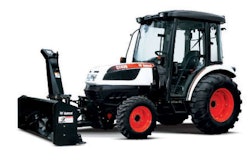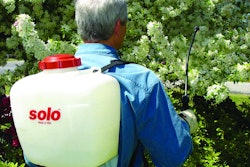4 reasons to add a mini loader to your fleet
By Jennifer M. Holloway
Mini utility loaders differ by manufacturer, but the essential design of each machine remains the same: stand-on or walk-behind capability and small size. Though small in stature, the benefits of a mini are huge. Consider adding a mini loader to your fleet, especially if your company does mostly residential and small commercial jobs. Renting is an easy way to determine its worth. “It’s one thing to look at specs,” says Greg Lawrence, Toro marketing product manager. “It’s another to use it in your environment.”
1 Maneuverability. The primary benefit of a mini loader is access; most will fit through a 36-inch gate. Along with access, the stand-on capability provides the operator 360-degree visibility—something you don’t have with cab models. The light footprint of tracked models is another plus, according to Lawrence. “It’s difficult to go into an existing job with larger equipment and not cause collateral damage.”
2 Flexibility. These machines were designed to enhance hand labor and bring a hydraulic machine into previously unreachable areas. Rob Gilles, marketing manager of Bobcat, offers the example of a quick patio paver project. Instead of excavating the pad by hand, use a mini loader to dig out and haul away debris. The project is done faster, freeing up workers and equipment for more jobs. Lawrence also sees a benefit of using the operator as a laborer. “In cab machines, the operator is tied in, and you typically have two additional laborers,” he says. With the walk-behind loader, the crew is downsized automatically. Many contractors will do the large part of the project with a bigger machine and then use a mini to finish the job. This frees up the more expensive machines to move on to other projects.
3 Attachments. The variety of attachments for mini loaders offers a host of benefits. From augers, trenchers and backhoes to boring units, stump grinders and forks, numerous attachments are available. Professionals can tackle irrigation work, wiring for lights and water feature installation. “Some of these aren’t typical landscape jobs,” Gilles says, “but they’re something a typical landscaper could do with an attachment. In this economy, people say you have to open up to different projects, and this is one way to do it at an economical price.”
4 Transportation and Operation. Another advantage to consider with mini loaders is the support equipment, says Jon Kuyers, utility products segment manager with Vermeer. Instead of a large truck and trailer, many models can be transported using a small pickup truck and a light duty trailer. And while training is required to operate larger cab machines, most experienced landscapers can walk up to a mini loader and start operating it. The maintenance is simple because the machine uses less hydraulics than larger loaders and isn’t a ride-on. “The overall initial cost upfront is going to be lower, and the operating cost is lower,” Gilles says. m
Note: The “mini loader” has many names based on manufacturer. Vermeer manufactures a stand-on mini skid steer in tracked and wheeled models. Toro manufactures a walk-behind compact utility loader with optional stand-on capability called the Dingo in tracked and wheeled models. Bobcat manufactures a walk-behind mini track loader with optional stand-on platform.









